Dog Breeds: Giant breeds
If you want to buy a book, clicking on the book cover
will take you directly to that book on the Amazon.co.uk web site.
See also:
 Dogs:
Breed profiles and breed books Dogs:
Breed profiles and breed books
 Dogs:
Health and Nutrition Dogs:
Health and Nutrition
 Dogs:
General Dogs:
General
 Dogs:
Origins, canine evolution and wolves Dogs:
Origins, canine evolution and wolves
 Training, puppy and adult dog good manners Training, puppy and adult dog good manners
 Advanced training, including gundog training Advanced training, including gundog training
 Fiction
and biography relating to dogs Fiction
and biography relating to dogs
 Click
here for dogs on stamp Click
here for dogs on stamp
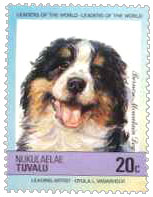
Click on the above image to
see more
stamps featuring dogs
General overview
The dogs in this category are all big. There are some wonderful breeds here,
but think carefully before you take a decision to share your life with one
of these dogs. They not only occupy a lot of space on the bed and block your
line of vision to the TV, these very big breeds also tend to be vulnerable
to a range of health problems which can cut short their lives. Common health
problems include bloat, abnormal bone growth, and cancer. There are other
large breeds which share this vulnerability to bloat, especially among sighthounds,
but giant breeds are especially prone to bloat. It's a condition caused by
a build-up of gas, which can lead to torsion, or twisted innards, and the
gas being trapped, which is very painful and can be fatal unless treated rapidly.
There have been a number of studies on bloat. Recommendations include feeding
at least two small meals rather than one large meal, and giving dogs rest
before and after they eat. Previous thinking was that the best position of
the feeding bowl was to be raised, but this has changed, and it is now thought
to be better to have the bowl at ground level. There may be a genetic element
to this vulnerability to bloat. Bone growth is affected by both feeding and
exercise, so it's important to give your pup the right food and the correct
level of exercise for his age. A vet should be able to advise you on the latest
research on food and exercise, and give advice to avoid both bloat and bone
problems. Hypothyroidism is also common in some of these breeds, such as Mastiffs,
Neopolitan Mastiffs, and Great Danes, and it has been linked to both skin
and behavioural problems.
It is always worth checking on the longevity of the ancestors of any pup
you take on, but this is especially true in the case of giant breeds. Don't
believe what thumbnail breed guides tell you about how long these dogs live,
since surveys of actual dogs often paint a different and more depressing picture.
Go up the family tree of any pup you are interested in, and find out whether
the dogs in it are still alive, and if they aren't, how old they were when
they died. This gives you some idea of how common early deaths are. Then add
up total years, and divide by the number of dogs, to get a rough idea of the
average longevity of a particular line. It's worth doing this before you see
the pup, and common sense flies out of the window because you become mesmerized
by how cute the pup looks!
People who own big dogs are usually well aware of the need for proper training
- many would love to be lap dogs and jump up to greet you, and they need to
learn some self-control. Irish Wolfhounds are sighthounds, and the size of
a small pony, so if they pull on the lead, you tend to go with them. Good
manners are best taught from puppyhood, because it's easier, but adult rescue
dogs can still learn fast. The best time to teach good manners to a rescue
dog is as soon as the dog arrives. That is when the dog is watching you to
learn what the rules are. It's tempting to spoil the dog a bit, because you
feel sorry for him or her. But it's kinder in the long run to let the dog
know gently and firmly what you consider to be appropriate behaviour. Rescue
centres usually have their own behaviourists and provide ongoing help for
adopters. Gwen Bailey's 'The Rescue Dog' is
also full of good advice.
Many other breeds mentioned here were developed as livestock guarding dogs,
and they include Mastiffs and Pyrenean Mountain Dogs. A dog whose job it was
to guard a flock had to be independent, and able to take decisions without
the owner being present, as well as trustworthy enough not to eat lambs -
though they were also carefully socialized with flocks. This independence
and generally calm nature is evident in the breeds kept as pets - some owners
describe them as gentle and stubborn. The independence means that patience
and persistence is needed in training them. These breeds also have a natural
tendency to guard, so don't need to be taught their job, rather it's wiser
to socialize them as much as possible with people, not just when they are
pups, all through their lives, so they continue to be accepting of people
you want to bring into your home. Socialization with people won't prevent
them from being good guard dogs and looking imposing enough to deter intruders,
while it does mean that they will allow you to have visitors in your home,
and that small children should be safe if they stray into your garden. Some
natural guard dogs, such as Neopolitan Mastiffs, are best reserved for experienced
owners, since they can be challenging dogs in terms of character, as well
as being very powerful. Even gentler dogs like Newfoundlands whose job it
was to rescue people also tend to be independent souls, since they also had
to take decisions alone, so again they need patience, consistency and a fair
amount of skill in training. It's well worth finding yourself a good trainer
who enjoys working with these breeds, especially if you are a novice owner.
It's also a good idea to research the ancestry of any large-breed pup you
plan to take on, to check for temperament. It is safer to have calm, even-tempered
dogs, capable of learning to back off when their owner asks them to. Very
big dogs which are easily spooked are more likely to bite out of fear, so
a stable, predictable temperament is important. Boldness can be an advantage,
since it means that a dog is less likely to be spooked, so long as the bold
dog has been taught good bite inhibition as a pup, and its inclination is
to stand in the way of uninvited visitors, rather than attack them. The visitor
could be a friend or child who has innocently walked into your house. Working
with a big, courageous dog takes a lot of commitment in terms of your time
spent training the dog. They also eat a lot, shed more than smaller dogs with
similar coats, as there is more of them, and it helps to find a vet who is
used to dealing with very big dogs.
Some breeds, such as Bullmastiffs, Neopolitan Mastiffs and Great Danes, may
take a dislike to some or all other dogs when they become adults, despite
careful socialization. It is safer to walk in areas or at times when there
are few or no other dogs about, and keep your dog on a lead. You may also
need to deter owners of other dogs who let their Fluffy come and yap in your
dog's face, reassuring you that Fluffy is very friendly. Some owners of dog-aggressive
dogs use a muzzle on walks, though muzzles don't always give total protection,
and close encounters with other dogs are best avoided. Dogs off the lead which
plague your dog and risk their own life and limb can often be deterred with
a water pistol - so long as you can find one that doesn't leak in your pocket.
Obedience training is especially important for those breeds which have a
tendency to dislike other dogs, so that you can safely take them out in public
places. You may not be able to get your dog to be friends with other dogs,
but he should be able to ignore them and pay attention to you.
Should very big dogs be walked off-leash in public places? This depends
on how trustworthy they are, and how safe the public place is. Generally,
Newfoundlands and St Bernards can be let off fairly safely, and much more
caution should be exercised with the other breeds. Irish Wolfhounds are generally
friendly, but can knock people over with a sighthound dash. Individual dogs
vary greatly in terms of how trustworthy they are. All dogs need excellent
recall in a fenced area like a garden before you risk letting them loose in
an unfenced area. You have little hope of getting them to come back in a public
place with distractions, like other dogs, if they won't do this every time
you call in a controlled environment like a garden. Practise recall every
day until your pup obeys every time, and carry on practising it, adding distractions
after the basic recall has been mastered. You need to be sure that your dog
is proofed against temptations he is likely to meet, such as screaming, rushing
children, and other dogs playing games, before you let him off anywhere near
people. You can arrange recall exercises with distractions in a safe, fenced
area. If in doubt about your dog's recall, keep him on the lead. Adolescent
dogs tend to cause the most problems, because they are usually livelier, and
can go through spells of being less obedient than you expect. Youngsters can
be very frightening to some people just because of their size, however friendly
their intentions. The dog's intentions could be misinterpreted, and someone
who does not understand dogs may fear that a friendly greeting means that
the dog is going for their throat. This may sound daft to you, but if it could
still result in a court case. Some of the more dog-aggressive breeds may also
surprise you by suddenly reacting badly to other dogs, especially as they
go through adolescence. Again, it's safer to be cautious, anticipate trouble,
and keep these dogs on the lead when other dogs are about. A dog-aggressive
individual of a very large, powerful breed can seriously injure or kill another
dog, and it can happen very fast. The trickiest areas to walk big dogs are
those places that are densely populated with children and/or other dogs, and
it's safest to keep your dog on the lead in those areas. The best areas to
walk big dogs are open spaces a long way from traffic, where not many people
walk, and where you have a good line of vision, so can avoid trouble. Then
it's possible to let dogs with good recall off the lead, calling them to put
them back on the lead if you see anyone approach they might annoy. Dogwalkers
who walk the same area regularly at the same time tend to get to know each
other, so you and your dog are likely to work out quite quickly who you both
get on with. Letting your dog off the lead is ultimately an issue of personal
responsibility, and assessing risks. Keeping him on the lead when in doubt,
and teaching him good manners, is much safer, and can win you both a lot of
friends.
'Health warnings' apart, these are magnificent breeds. People who have the
space to house dogs of this size can enjoy the company of dogs with presence.
Well-bred, well-trained and well-socialized individuals are usually gentle
giants, very tolerant of, and well bonded to their own 'human family'.
Breed Profiles

Click on the cover above
to go to this book
at Amazon.co.uk
|

The Bernese Mountain Dog: An Owner's Guide to a Happy
Healthy Pet
Crawford
Hungry Minds Inc
ISBN: 1582451621
Bernese Mountain Dogs are very attractive dogs with tricolour markings
and thick coats, which look cuddly and stay puppyish for a long time.
They aren't as big as some of the dogs featured on this page, but still
look larger than life. They were developed as general purpose farm dogs,
carrying out duties such as herding, guarding and even pulling heavy
burdens. They can learn herding, but tend not to perform as well as
the more specialized herding breeds. They need a skilled trainer, since
they learn fast, but they are sensitive dogs and can sometimes get confused
and anxious if they are not trained patiently. Like many dogs which
have been used for livestock guarding, Bernese Mountain Dogs tend to
bond well with their owners, and can be a little reserved with people
they don't know. Socialization with people of all ages and appearances
is especially important for any large breed dog, though Bernese Mountain
Dogs are generally very patient and tolerant with children. They also
tend to get on well with other dogs and cats living in their household,
though again socialization is important. They can be quite barky, which
is good if you want a watchdog, not so good if the dog is left outside
unattended and the neighbours complain! They shed a lot in spring time,
and to a lesser extent in the autumn. The big problem with these dogs,
however, is their vulnerability to cancer and hip dysplasia, so it is
important to check the health record of the parents of any Bernese Mountain
Dog pup you are interested in buying. Many of these dogs die young due
to cancer, which reduces average life expectancy.
This book is a very good guide to the breed, covering its history,
general care, training, and health issues. It's well written, and funny
in parts, and will bring nods of recognition from Bernese Mountain Dog
owners.
 Top
of page Top
of page
|
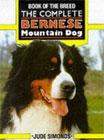
Click on the cover above
to go to this book
at Amazon.co.uk
|

The Complete Bernese Mountain Dog (Book of the Breed)
Simonds
Ringpress Books
ISBN: 0948955651
This is a little more in-depth than Crawford's book, and is well-researched
and up-to-date. it is also very well illustrated. It's a bit more expensive
than Crawford's book, but is more likely to interest experienced owners,
since it provides more in-depth coverage of the breed.
 Top
of page Top
of page
|

Click on the cover above
to go to this book
at Amazon.co.uk
|

The Bullmastiff Manual (The World of Dogs)
Bill Walkey
Kingdom Books
ISBN: 1852790350
Bullmastiffs were developed as guard dogs and for catching poachers.
They are part Mastiff, crossed with the ancestor of Bulldogs. They are
not quite as tall or as calm as Mastiffs, though they are calmer than
most bull terriers. They are strong-willed dogs which tend to bond strongly
with their human family, and love attention. This desire for attention
can be harnessed in training them. Well-trained and well-socialized
Bullmastiffs tend to be very good with children, though they are not
always well-behaved with other dogs, even after socialization as pups.
These dogs are natural guard dogs, and will detain intruders. They
should not be taught to distrust strangers. Even well-socialized Bullmastiffs
tend to be reserved with strangers, and are bold and fearless if threatened.
They are large, powerful dogs. Extensive and ongoing socialization is
important, as is training, so you can get your dog to leave people alone
when you ask. They need to have house rules made clear to them from
when they are pups, and taught not to jump up or pull on the leash,
from when they are little, because they don't stay little for long.
They can switch off if they are shouted at in training, and benefit
from working with a calm, even-tempered trainer.
Bullmastiffs are best kept by people who have a lot of space, because
they need exercise to stay fit, and it's not always easy to take such
big dogs out on walks, especially if they take a dislike to some of
the local pooches. They do benefit enormously from going out and about
though, even if you have to time your walks so they don't have to meet
a lot of other dogs. Bullmastiffs don't do well in outdoor kennels,
tending to prefer the company of their human family. They are not dogs
to leave tied up unattended on a chain, since they don't stand sun or
cold well, they suffer if they are left isolated, and are not safe from
being teased by people at a distance. Anyone who teases and comes close
to a chained Bullmastiff could be hurt, and seriously hurt in the case
of a child. A Bullmastiff left outside unattended a lot is also likely
to develop behavioural problems.
Common health problems include tumours, hip dysplasia, bloat, heart
disease hypothyroidism, and eye trouble such as entropion. Like most
members of the bulldog family, they may suffer from breathing difficulties
and snore, as well as drool. They also tend to suffer from extremes
of heat or cold. They do need exercise, but are not running-around dogs,
and prefer to walk at a dignified pace with their owners. Bullmastiff
pups shouldn't be pushed into overexerting themselves by jumping a lot,
since this can affect their bone growth.
This book is a classic which has been revised and updated, There is
help on all aspects of Bullmastiff ownership, as well as a lot of information
about the breed and how it is kept. It's clearly written, and is very
helpful for novice Bullmastiff owners, as well as being informative
enough to interest experienced owners, It's also very well illustrated.
 Top
of page Top
of page
|
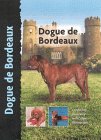
Click on the cover above
to go to this book
at Amazon.co.uk
|

Dogue De Bordeaux
Joseph Janish
Interpet Publishing
ISBN: 190238914X
The Dogue de Bordeaux is a powerful, strong-willed dog which has some
similarities to the Neopolitan Mastiff. Well-bred individuals are generally
calm and well-behaved with people they know, and they can be very good
with children who respect them, but young dogs can easily knock over
children in play, and have been known to knock over adults. These dogs
may also drool all over you. Pups need to be taught not to jump up,
and to play gently with people. The modern version of this breed is
generally patient and tolerant with its human family, but the breed
was originally designed to be aggressive, and it is important to check
the temperament of both parents of any pup you are interested in. The
Dogue de Bordeaux is a natural guard dog, which should be socialized
extensively as a pup, so that the adult is safe with people. Socialization
should continue throughout the dog's life. Teaching your dog to behave
well with a range of people will not prevent this breed from carrying
out guard duties - it has a naturally strong drive to guard and protect.
This is an intelligent breed, which can learn fast, but can also be
headstrong and will pick up on any inconsistencies in how you enforce
house rules, so skill is needed in training. The Dogue de Bordeaux does
best with an experienced owner who has already worked with large, headstrong
breeds, and who is able to be firm, consistent and calm. These dogs
do not like being teased, and they have good memories, so children and
visitors should be warned. It's safer to keep children and dogs separate
if you have a lot of young visitors who don't understand dogs, and might
plague your pet.
Socialization with other dogs as a pup may not be enough to prevent
aggression against other dogs in an adult Dogue de Bordeaux. This means
that they should be walked in public parks with care, and always on
a lead. They need a fair amount of space, such as a large garden, since
these dogs should be active to stay fit, and can't always be walked
easily. They do benefit from frequent walks at a reasonable pace, and
need to see the outside world, so that they are not spooked when you
have to take them out. You may need to develop strategies for safe walking,
such as going out very early, if your dog takes a dislike to most others
he meets, and you live somewhere where there are a lot of other dogs.
It's also worth making sure you can see whether another dog is coming,
if bumping into another dog as you turn a corner could create problems.
Novice owners can benefit from training classes with someone who has
experience of mastiff-type dogs, and who enjoys working with them. Obedience
training means that you should be able to get your dog to ignore other
dogs that don't come foolishly close, even if he is dog aggressive.
Common health problems include hip dysplasia, juvenile lameness, heart
trouble, skin disease, hypothyroidism, and bloat. Pups need careful
regulation of their food and exercise so that their bones develop properly,
as is the case with most big dogs.
This book is a very good introduction to the breed, which gives a lot
of helpful information on general care, including health care. It is
well illustrated, and should interest experienced and novice owners.
 Top
of page Top
of page
|

Click on the cover above
to go to this book
at Amazon.co.uk
|

Your First Great Dane
Angela Mitchell, Steve Tyler (Illustrator)
Parapress
ISBN: 1898594678
Great Danes are a magnificent breed, more refined than a mastiff, though
they probably have fighting mastiff in their background. Careful socialization
of puppies is very important with a dog of this size, both with humans,
and you need to find them puppy playmates who are robust enough with
withstand their strength. Training should start from when they are pups,
since it's easier to teach them the rules while they are small. Well-trained
and well-socialized Great Danes are generally friendly with people they
are introduced to by their owners, and are still capable of looking
serious with uninvited guests. It is counter-productive to try to teach
them to be guard dogs. Few intruders would want to walk past a Great
Dane standing in their path, even if the dog looked friendly.
Some Great Danes are can be dog aggressive, especially entire males
with other entire males, though this breed can be very tolerant of smaller
dogs that bark or yap at them, worried by their large size. Great Danes
are not an ideal breed for people with more than one dog, since they
need more than average handler skill in multi-dog households, though
if you have a Great Dane and want to take on a second dog, the safest
thing to do is to allow your dog some say in who he or she lives with.
This has benefits other than ensuring that your new dog is well matched
with your Dane - dogs often dislike other dogs with 'issues', or bad
manners, so the chances are that your Dane will weed out problem dogs
for you. Taking on two Great Danes of the same sex is an especially
difficult task, so is not recommended. Careful selection of pups for
a calm temperament should help ensure your Great Dane has the potential
to get on well with other dogs. Ongoing socialization with calm, older
dogs as well as other pups, will build on this so that your Great Dane
gets on with other dogs on walks and in training classes. You may still
find your dog does not like some other dogs, and will need to avoid
areas with a high density of dogs, walking early, for example.
Generally the breed is tolerant with children, though supervision is
important. Children should respect Great Danes, and never tease them
or encourage them to indulge in rough play indoors when they are pups.
Great Danes can cause a lot of mayhem when they are in a boisterous
mood! It helps to include older children in obedience training programmes,
so that the dogs will lie down and obey other basic commands if the
children ask them to. Great Danes can be quite barky dogs, especially
if left alone a lot or bored. Their bark is very deep, so they are very
good watchdogs. They don't need a lot of grooming. They do need exercise,
but of the right kind. As with all giant breeds, youngsters should not
be allowed to over-exert themselves, so long periods of mad running
around and jumping are not a good idea, and it's a good idea to give
them a rest after they have been running around. Youngsters may also
need rests on walks. Adults really need a daily walk, which means that
obedience training is important so that you can trust them not to pull
the lead out of your hand in public places.
Common health problems include heart trouble, hypothyroidism, arthritis,
cancer, including bone cancer, and hip problems. As large-breed dogs,
Great Danes are also vulnerable to bloat, and their food and exercise
should be carefully regulated while they are growing.
Angela Mitchell's book is an excellent introduction to the breed, which
is ideal for novices. It's very funny, as well as very informative,
and prepares you for what is to come, if you own a Great Dane puppy.
It can also be very helpful as a reference book for preventing problems.
 Top
of page Top
of page
|

Click on the cover above
to go to this book
at Amazon.co.uk
|

The Great Dane (An Owner's Guide to a Happy, Healthy
Pet)
Jill Swedlow
Hungry Minds Inc
ISBN: 0876054459
This is a very good guide to caring for and training a Great Dane
throughout all life stages, from puppyhood to old age. There is a lot
of help with general care, including health care, and the joys of living
with a giant breed. There's also a good account of the breed's history,
and there are tips on showing. Ideas are set out for activities to do
with your Great Dane, such as obedience trials and games. The book is
also well illustrated.
 Top
of page Top
of page
|

Click on the cover above
to go to this book
at Amazon.co.uk
|

The Irish Wolfhound
Linda Gover
Kingdom Books
ISBN: 1852790776
Irish wolfhounds are very big dogs indeed, and just one can make your
house seem very small, often knocking things over without meaning to.
They do best with a large, fenced garden, like most sighthounds, and
also like being taken for walks. They are usually affectionate, and
get on well with children, though they should be supervised with smaller
children, because they are such big dogs and can easily knock people
over if they get boisterous. They also usually get on well with other
dogs, even those from small breeds. Other dogs which are often nervous
of big dogs seem to sense that Irish Wolfhounds are gentle, and don't
mind their being big. Irish Wolfhounds have different playing styles,
and tend to be well-behaved and calm with small dogs, but youngsters
especially will sometimes invite medium and big dogs for a chase game.
This can end in an amiable wrestling match, with the Wolfhound attempting
to pull the other dog to the ground, and usually winning, as it is the
bigger dog. Some dogs hugely enjoy these games with Wolfhounds, but
do check with the owners of the other dogs if you sense a chase is coming
on. The games can be a little alarming to watch for people who do not
know that Wolfhounds are generally big softies, and aren't trying to
hurt their dogs. You also need to check that the playmate is robust
enough to withstand the game, though Irish Wolfhounds tend only to play
this way when their invitation has been taken up, and the other dog
is willing.
These dogs are also likely to fill your house with mud, try to be lap
dogs, and don't have to try very hard to steal things from tables and
kitchen work surfaces. Training in house rules is therefore very important
from when they are pups. They can learn commands well if you are consistent
from the start, though they aren't as easy to train as Labs and Golden
retrievers, so consistency is important. If, for example, you don't
want such a big dog on the furniture as an adult, never allow your pup
to climb up on the sofa with you! Pups also need to be taught not to
pull on the lead, and some degree of recall, so that you can take them
for walks without being pulled around. They need a firm, but gentle
approach, because they are quite sensitive and keen to please, even
if they don't always do what they are asked!
Irish Wolfhounds aren't usually very barky dogs, and are not much good
as guard dogs, because they are usually very friendly with everyone
they meet. They need a fair bit of grooming. Despite their having rough
coats, they aren't dogs to be left outdoors. They are far too sociable,
and like to be with their human family. They aren't especially bad as
shedders, though of course adult Irish Wolfhounds are very big, so there
is more surface area from which hairs can fall!
The biggest drawback with Irish Wolfhounds is their vulnerability to
health problems. They can suffer from problems with bone growth if not
fed and exercised properly as puppies. Adults are enormous, so youngsters
grow very fast and take a long time to mature. They need especial care
to ensure that they eat the right food and don't overtax themselves
while they are growing. Give the pup a rest on walks if he looks like
he needs one, and after he has been running round, whether or not he
wants a rest. Cancer, liver trouble, gastric torsion (bloat) eye trouble,
Von Willebrands, and heart disease can also cut short their lives, and/or
cost you a lot in vets bills. Choosing a healthy pup is important, and
this involves asking questions about the longevity of your pup's ancestors.
Linda Gover has kept Irish wolfhounds for two decades, and her love
of these very special dogs is evident. There is information on the breed's
history, and on outstanding kennels specialising in Irish wolfhounds.
She also deals with the health problems of the breed, and is frank about
one of their main drawbacks - their relatively short lifespan for a
dog. Obedience training is also tackled - important when you have a
dog which is the size of a small pony when adult! Anyone considering
owning an Irish Wolfhound would do well to start here, to get some idea
of what they would be taking on, as well as understanding the appeal
of this affable breed.
 Top
of page Top
of page
|
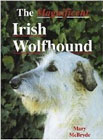
Click on the cover above
to go to this book
at Amazon.co.uk
|

Magnificent Irish Wolfhound (A Ringpress Dog Book
of Distinction)
Mary McBryde
Ringpress Books
ISBN: 1860540937
Mary McBryde has written a very useful up-to-date reference book for
Irish Wolfhound owners, It's a little expensive, but well worth the
investment, because the breed needs quite a bit of care to avoid common
health problems. This is especially true during puppyhood, since food
and exercise are critical to the development of Wolfhounds. This book
is clearly written enough for a novice, and has enough information for
experienced owners. It's certainly worth reading if you plan to take
on Wolfhounds, since they can cost a lot in feeding and vet bills, and
take up a lot of space. Choosing a pup is important, given the prevalence
of inherited health problems, and there is help with this. The book
is honest about the demands made by the breed, but also helps you cope
with them, and conveys the joys of owning an Irish Wolfhound.
 Top
of page Top
of page
|
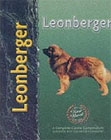
Click on the cover above
to go to this book
at Amazon.co.uk
|

Leonberger (Pet Love: Special Rare Breed Edition)
Madeline Lusby
Interpet Publishing
ISBN: 1842860550
Leonbergers are very big, strong, handsome dogs with tawny coats,
though their majestic appearance is sometimes spoiled by drool. They
have thick manes, bushy tails, and feet designed for swimming. Leonbergers
are generally calm, even-tempered and affectionate. They have been used
as watch dogs, sled dogs and tracker dogs, though they should have exercise
carefully regulated and should not overexert themselves while they are
growing.
These are big dogs, they can be bigger than St Bernards, and can easily
knock over small children and other dogs, so they need obedience training
from when they are pups. Recall, and learning to walk on the lead without
pulling are especially important. Their calm nature shouldn't be taken
for granted - unsocialized Leonbergers may be fine with you, but they
are not much fun to take out on walks, and can be very frightening for
anyone they bark at! They aren't especially barky, but they have deep
barks, and are natural watchdogs, so should be trained to be friendly
with people. They will still be extremely effective guard dogs, however
much socialization you give them, since they look imposing and serious.
Well-trained Leonbergers can still be a little aloof with people they
don't know, but are generally tolerant with children of the family.
They will tend just to walk away if children tease them, but you shouldn't
rely on this, and supervision is important for the sake of the dog as
well as the children. This breed also needs careful, ongoing socialization
with other dogs. They are so big that they often trigger barking in
passing dogs, and have to be able to handle this without reacting. They
can also push over frailer dogs if they get too bouncy. Leonbergers
do need daily walks to keep fit, so it's important to give them obedience
training from when they are pups, so that they don't pull on the lead,
and they come back as soon as you call, if you think they are about
to annoy people or other dogs. Well-trained Leonbergers are generally
reliable, but untrained Leos can be quite frightening to people and
dogs they rush up to. They should be kept on the lead on walks if you
can't trust them to behave well. They love swimming.
Leonbergers need regular brushing, to help keep down the level of dog
hair in your home, and they do shed a lot when they moult, especially
during the spring moult. Common health problems include hip dysplasia
and eye trouble, as well as the usual giant breed problems of bloat
and abnormal bone growth if food and exercise are not regulated properly
when they are pups. It's worth checking for hypothyroidism if a Leonberger
develops behavioural problems. They also don't tolerate heat well, so
shouldn't be walked in the heat of the day in summer.v
This book is an introductory guide to the breed, which covers behaviour
and training, as well as general care. It's suitable for novices, though
is not likely to provide much new information for experienced owners.
 Top
of page Top
of page
|

Click on the cover above
to go to this book
at Amazon.co.uk
|

Leonberger (The World of Dogs)
Angela White
Kingdom Books, Havant
ISBN: 1852790644
This guide to Leonbergers was written by someone who has several of
these dogs, and she gives a very clear idea of what it's like to live
with them. It's a very useful reference book both for novices and experienced
owners, with a lot of help with training and behaviour. There's also
help with nutrition, and other aspects of caring for this breed. It's
more expensive than the Pet Love guide, but you get more for your money.
 Top
of page Top
of page
|
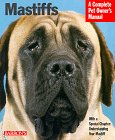
Click on the cover above
to go to this book
at Amazon.co.uk
|

Mastiffs: Everything About Purchase, Care, Nutrition,
Grooming, Behaviour and Training (A Complete Pet Owner's Manual)
K. Thornton
Barron's Educational Series
ISBN: 0764107623
Mastiffs are very large, powerful looking dogs which were developed
to guard livestock. They are generally calm, though individuals vary.
Like all large dogs, they need to be carefully socialized with people
and other dogs, and trained in acceptable behaviour while they are small,
and it is easier to get them to do what you want. Well-socialized and
well-trained Mastiffs can be excellent companions for children, though
they need supervision, since they are very large dogs which can easily
knock small children over. Many children have fond memories of playing
with mastiffs, and generally these dogs are patient, with nice natures.
It is important, however, to check out parents of possible pups, to
see if they are friendly with stable temperaments. Mastiffs can vary
in terms of how pushy and headstrong they are, and how friendly they
are with strangers. A family Mastiff needs to be especially calm and
friendly. It's worth asking breeders about the characteristics of their
lines, and looking at pups from different litters, as well as comparing
pups from the same litter, so you have the best chance of finding a
pup that is likely to suit you.
Mastiffs need a firm, but gentle hand in training, and should be taught
basic obedience skills, such as sitting, staying, and walking nicely
on the lead, from when they are pups. They don't respond well to shouting,
and are too big to be pushed around. They like to please their owners,
though they don't always obey. Consistency pays off, as well as never
rewarding bad behaviour, and only giving rewards, like opening the door
for a walk, when the pup is calm rather than pushing to go out. It is
unwise to teach Mastiffs to be wary of people. They aren't especially
barky, but they are natural guard dogs, and do not need to be taught
to look imposing and frighten intruders. You want them to be gentle
so that visitors are safe, while their sheer size and seriousness will
deter unwanted guests. Even the friendliest Mastiffs don't usually allow
visitors into the home unless their owners give permission to the visitor
to enter. Well-trained Mastiffs won't bite intruders, but rather detain
them until someone arrives.
Mastiffs should be socialized with other dogs when they are pups, and
socialization should be ongoing. Adults may still become dog-aggressive,
but, with enough obedience training, they should be able to ignore other
dogs that don't come very close. They should be walked on a lead in
public places, especially near children and other dogs, and obedience
training is important, since a Mastiff that decides to take off can
easily pull over the handler.
These dogs cost a lot in food, and are often given up because owners
find they simply take up too much space, and eat a lot. Look at the
parents of any pup you are interested in, and think ahead. Do you have
enough space for such a big dog? They can also drool, some more than
others, which can also put some people off, but they tend not to need
a lot of grooming.
Common health problems in Mastiffs include breathing difficulties,
which can lead them to snore, heart disease, hip dysplasia, eye problems,
and the two big problems common to giant breeds, vulnerability to bloat,
and bone disorders if they are not fed properly as pups.
This book is a good introduction to Mastiffs, and can help you decide
whether you want to take one into your home. It's a bit too short to
give you all the information you need for your dog's lifetime, but gives
a good overview, and is inexpensive.
 Top
of page Top
of page
|

Click on the cover above
to go to this book
at Amazon.co.uk
|

Neapolitan Mastiff: Complete Handbook
Robert Gravel, Gonnie Schaffer
TFH Publications
ISBN: 0793807840
Neapolitan Mastiffs are big, powerful dogs which can look quite fearsome,
but well-bred, well-socialized and well trained individuals are generally
calm and affectionate with people they know well, and very good with
children who respect them. They develop strong bonds with their human
family.
Socialization is very important throughout the dog's life, starting
from puppyhood, so that they behave well with your visitors and allow
you to let people in! Neopolitan Mastiffs also need to have house rules
set out clearly from when they are pups, and this should include not
jumping up, and no rough games indoors, since they grow to be very big,
and what is acceptable in a pup can become a problem with an adult dog.
They are intelligent dogs who pay attention to their owners, and this
includes picking up on any inconsistencies about what they are allowed
to do, so it's important to be consistent, for example always putting
pups in a sit before you go through a door, only opening the door when
they are sitting, and only allowing them to go through the door when
you ask them to, so that they don't pull you through the door when they
are adults. They get bored with repetition in training because they
learn fast, so it helps to vary their routines and keep them on their
toes.
Children need to respect these dogs, which do not like to be teased.
This is important if you have a lot of visiting children who do not
understand dogs - it is safer for dog and visiting children to keep
them separate. Neopolitan Masitiffs are also large, powerful dogs, and
can easily knock over small children, so supervision is important.
Adult Neopolitan Mastiffs can become aggressive with other dogs, especially
entire males, even if you have socialized them carefully, so you will
need to take precautions on walks. They do need to get out and about
regularly, so that they keep fit and are not spooked when you have to
take them out.
These dogs tend to be wary of people they don't know, and, along with
the Dogue de Bordeaux, have a stronger natural tendency to guard than
most breeds on this page. They aren't especially barky, but will stand
their ground with strangers who are not introduced to them. Neopolitan
Mastiffs like to be with their families, so they aren't happy being
left outside as guard dogs, and are likely to develop behavioural problems
if they are isolated. They should never be tied up on a chain and left
to the mercy of anyone who might want to tease them. Children wandering
near a chained dog could also be at risk.
These dogs don't need a lot of grooming, but they can drool a lot,
especially when it's hot. They need protection against the sun in summer,
with access to shade and water. Common health problems include eye trouble,
hip dysplasia, hypothyroidism, and bone growth abnormalities. Pups need
to have food and exercise carefully regulated.
These dogs are best reserved for people who have the knowledge and
time to select the right pup, socialize and train the pup properly,
and who are organized enough to continue with socialization and manage
the dog well. They are not good family dogs except in the hands of the
most committed and skilful owners. People who want a large, black family
dog that is likely to drool and suffer health problems are better off
getting a Newfoundland!
This book is a good introduction to the breed as far as it goes. It
can help you to decide on whether to share your life with a Neo, but
you really need more information if you have already taken one on.
 Top
of page Top
of page
|

Click on the cover above
to go to this book
at Amazon.co.uk
|

The Official Book of the Neapolitan Mastiff
Sherilyn Allen
TFH Publications
ISBN: 0793820839
This book is an in-depth guide to Neopolitan Mastiffs which is a very
useful reference book for novice and experienced owners alike. It is
a little expensive for a breed guide, but is likely to be used a lot
in the dog's lifetime, so is worth the investment.
 Top
of page Top
of page
|
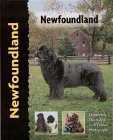
Click on the cover above
to go to this book
at Amazon.co.uk
|

Newfoundland (Pet Love)
Angela Barlowe
Interpet Publishing
ISBN: 1903098726
Newfoundland dogs have many staunch fans, for they are a very tolerant,
cuddly breed, and larger than life. One of their roles as working dogs
is to rescue people from water, and they are also good retrievers. They
have been credited with saving many lives, and are designed to be excellent
swimmers. They are generally very friendly, tolerant dogs, and good
with children. The working background of Newfoundlands makes them more
suitable as family pets than the guarding breeds, because Newfoundlands
are more likely to behave well with your children's friends when they
call round. They are generally very patient dogs with small children,
but can still knock children over, since they are such big dogs, so
supervision is important.
These dogs tend to develop very strong bonds with their owners, and
can be very sensitive to their owner's displeasure, so they do need
to be trained with patience, since they can switch off with rough treatment
or shouting. Newfoundlands have been bred to work independently, as
rescue dogs, and this independence in such an affectionate and responsive
dog can surprise owners. Training should start from when they are pups.
Youngsters shouldn't be encouraged to play roughly with people, or jump
up, because they grow to be so big. Ongoing informal training helps
teach them house rules. Socialization with people is important, as with
any dog, though Newfoundlands tend to be easier to socialize than many
breeds. They are usually courageous and protective of their human families
without making threatening growls, placing themselves between their
humans and any perceived threat. Visitors who are introduced to them
tend to receive a friendly welcome, sometimes complete with drool.
Generally, they are good with other dogs, though socialization is important,
and some males can take a dislike to other male dogs. Like all large
breed dogs Newfoundlands take up a lot of space. They can also drool,
and they can shed a lot, especially in spring. They don't need a great
deal of exercise, but should have at least one daily walk. They love
to swim, and were bred to be good swimmers.
Care should be taken with their diet and exercise while they are pups,
so their bones develop properly, and they should not be allowed to put
on weight as adults, which can lead to joint problems. Other common
health problems include hip dysplasia and inherited heart disease. Newfoundlands
need protection from the sun in summer, and should only be taken out
in the early morning and after dusk when it's very hot, because they
can suffer from the heat with their thick coats. They need frequent
grooming during their twice-yearly shed. More is shed in spring than
in autumn.
Angela Barlowe has written a good introductory guide to Newfies, which
is well illustrated and clearly explained. It is a good introduction
for novices, though doesn't really go deeply enough into the breed to
interest experienced owners.
 Top
of page Top
of page
|
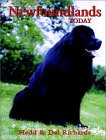
Click on the cover above
to go to this book
at Amazon.co.uk
|

Newfoundlands Today
Richards
Hungry Minds Inc
ISBN: 0876052464
This book is a very good guide to Newfoundlands with extensive information
on the breed's history, and good advice on choosing a pup. There's also
a lot of help with breeding Newfies, and some good advice on health
care. It's a useful reference book for experienced Newfoundland owners,
as well as a good introduction for novices.
 Top
of page Top
of page
|
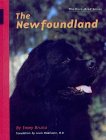
Click on the cover above
to go to this book
at Amazon.co.uk
|

Newfoundland
Emmy Bruno
Doral Publishing, Inc
ISBN: 0944875475
Emmy Bruno has written a useful guide to Newfoundlands which is of
especial interest to people wanting to breed these dogs. The book is
a little expensive for a breed guide, but the amount of detail provided
makes it worthwhile, for people who are especially interested in the
breed's history, breed standard, and other issues relating to breeding.
There is also good advice on general care, including health care.
 Top
of page Top
of page
|
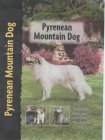
Click on the cover above
to go to this book
at Amazon.co.uk
|

Pyrenean Mountain Dog (Berger Des Pyrenees) (Pet Love)
Juliette Cunliffe
Interpet Publishing
ISBN: 1842860593
Pyrenean Mountain Dogs, also known as Great Pyrenees and Bergers Des
Pyrenees, are large, thick haired dogs which are mainly white, with
some colour on their faces. They were originally livestock guarding
dogs, and shepherds tended to favour white dogs, because it was easier
to tell the difference between them and wolves which might be stalking
the flock. They have also worked as draught animals and rescue dogs.
Pyrenean Mountain Dogs can usually perform well in terms of obedience,
so long as ground rules are set out consistently from when they are
pups, because they are quite independent.. These dogs are usually calm,
courageous, affectionate with their human family, and often reserved
with strangers. They are generally good family dogs, and tolerant with
children of the family, though of course supervision is important due
to their size, and they need to be socialized with children, like any
dog.
Well-socialized Pyrenean Mountain Dogs usually tolerate other dogs,
though some males sometimes take a dislike to other male dogs. They
usually get on well with any cats in the household. Pyrs can be quite
barky as a breed, which is good if you want a large, imposing watchdogs.
They may drool, and they tend to shed a lot in the spring. Their thick
coats mean that they can suffer when it is hot, especially if they do
not have access to shade. This means that they should be walked in the
early morning and after dusk, when it's hot. They do need regular walks
to keep fit, but their recall is not always instant, so they need a
safe fenced area, or one that is away well from traffic, if they are
to be let off the lead. Common health problems include skin problems,
hip dysplasia and other problems common to large breeds, such as bloat
and abnormal bone growth.
Juliette Cunliffe's guide is a good introduction to the breed, which
gives help with training as well as advice on general care, including
nutrition and health care.
 Top
of page Top
of page
|
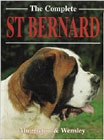
Click on the cover above
to go to this book
at Amazon.co.uk
|

The Complete St Bernard (Book of the Breed)
Muggleton, Wensley
Ringpress Books
ISBN: 0948955961
St Bernards are famous as rescue dogs. They are generally gentle, friendly,
and very patient and tolerant with children. They are very similar to
Newfoundlands, and, like Newfoundlands, need to be taught house rules
while they are pups, including no rough games indoors. They are such
big dogs, that they can easily knock over small people, not to mention
treasured ornaments. Like Newfoundlands, they are droolers, withstand
cold well, and shed a lot in spring time. St Bernards can also be quite
barky, and their barks are loud and deep. This means that they can be
good watchdogs, though they are too friendly to be guard dogs. There
are two types, longer and shorter haired St Bernards, and neither needs
a lot of grooming, though regular brushing helps them to look good and
cuts down on shedding. These dogs need especial care with their diet
and exercise while they are growing, to avoid problems with bone development.
Other common health problems include heart trouble, hip dysplasia, and
entropion. They can also suffer when it's hot, so should only be walked
in the early morning or after dark, during periods of hot weather. St
Bernards don't need a lot of exercise, though they do benefit from regular
walks, preferably at least one a day to keep fit. They are, sadly, not
a long lived breed, even for a giant breed, and heart problems are all
too common. Anyone interested in a St Bernard pup should do a lot of
research on the longevity of the pup's ancestors, and ask themselves
whether they could cope with losing their dog after a relatively short
time.
This guide gives an excellent overview of the breed, with good advice
on general care, as well as an informative account of the history of
the breed as a rescuing dog, and its rise in popularity as a companion
dog.
 Top
of page Top
of page
|
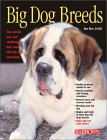
Click on the cover above
to go to this book
at Amazon.co.uk
|

Big Dog Breeds
Dan Rice
Barron’s
ISBN 0764116495
Dan Rice is a vet and well-known dog author. Here he has written an
extremely useful guide to the care and health of big dogs, which is
especially useful for its information on how to prevent health and other
problems associated with large breeds. The first part of the book gives
help on all stages of dog ownership, from finding a breeder, and choosing
a pup, to training, health and diet, breeding, and coping with the loss
of your dog. Some big dogs tend to have short lives and are prone to
particular health problems, especially the giant breeds, so the information
in this book is important for anyone who owns or plans to own such a
dog. The second part of the book deals with different big dog breeds,
with a breed profile for the most popular breeds. This book is very
useful for all dog owners, because there is so much information set
out in a clear, common-sense way. Big dog owners have to be especially
careful about diet and how the dog eats, to avoid problems that particularly
afflict big dogs, like gastric dilation and volvulus. One piece of advice
needs to be updated, however, and that is the recommendation for big
dogs to be fed using raised bowls - recent thinking has changed, and
ground-level bowls are seen as safer. Otherwise, the advice is generally
sound and clearly explained in a helpful way.
 Top
of page Top
of page
|
See also:
 Dogs:
Breed profiles and breed books Dogs:
Breed profiles and breed books
 Dogs:
Health and Nutrition Dogs:
Health and Nutrition
 Dogs:
General Dogs:
General
 Dogs:
Origins, canine evolution and wolves Dogs:
Origins, canine evolution and wolves
 Training, puppy and adult dog good manners Training, puppy and adult dog good manners
 Advanced training, including gundog training Advanced training, including gundog training
 Fiction
and biography relating to dogs Fiction
and biography relating to dogs
 Click
here for dogs on stamps Click
here for dogs on stamps
|